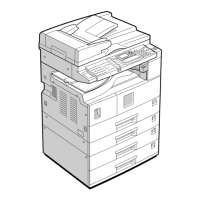
Do you have a question about the Ricoh 2015 and is the answer not in the manual?
| Brand | Ricoh |
|---|---|
| Model | 2015 |
| Category | All in One Printer |
| Language | English |
Provides an overview of the machine's components and initial setup procedures.
Explains how to use multiple machine functions simultaneously for efficiency.
Allows key operators to change or set machine defaults and operational parameters.
Provides explanations for common problems and messages, with solutions.
Details on accessing total counters and changing machine language settings.
Describes how to enter characters using the machine's control panel and keys.
Covers primary and extended security functions to protect documents and access.
Provides electrical and hardware specifications of the machine and its options.
Warns about potential hazardous radiation exposure from controls or procedures not specified.
Provides general notes about model variations and paper size notation.
Details machine overview, system settings, and troubleshooting for general settings.
Describes procedures for configuring the machine and computers in a network environment.
Details operations, functions, and troubleshooting for the copier function.
Describes operations, functions, and troubleshooting for the facsimile function.
Details advanced functions and settings for key operators.
Describes system settings and operations for the printer function.
Details operations, functions, and troubleshooting for the printer function.
Describes operations, functions, and troubleshooting for the scanner function.
Introduces the machine's core functions: copying, facsimile, printing, and scanning.
Explains sending fax documents from computers directly without printing.
Explains the meaning of symbols used throughout the manual for safety and operation.
Lists and defines major hardware and software options for the machine.
Identifies and describes the main external parts and features of the machine.
Details the available external and internal options for the machine.
Illustrates and explains the function of each key and indicator on the control panel.
Explains how to read the display panel and use the selection keys.
Explains how to switch between different operating modes of the machine.
Describes how to carry out another job using a different function while a current job is being performed.
Lists the available settings and their corresponding page numbers for system configuration.
Provides instructions for key operators to access and change system settings.
Details how to change the default settings for the machine's operations.
Allows adjustment of panel tone, copy count display, function, and print priority.
Allows selection of paper size and type for each paper tray.
Allows adjustment of timers for auto off, energy saver, and system reset.
Details settings for network and other interface connections.
Covers settings related to file transfer operations.
Allows control of machine usage by setting codes for users.
Specifies whether users are restricted or not based on key counter.
Specifies whether to use passwords to control Key Operator Tools settings.
Specifies whether or not to use the security function for enhanced protection.
Allows viewing and printing the number of prints for each function.
Provides step-by-step instructions for registering a new user code.
Details the procedure for modifying an existing user code.
Explains how to remove a user code from the system.
Shows how to check the copy counter for each user code.
Provides instructions on how to print the counter list for each user code.
Details the procedure for resetting the counter values to zero.
Covers managing user codes, sender's passwords, and program groups.
Lists user names, fax settings, and e-mail settings for registration.
Explains how to register destination names for fax and e-mail.
Provides instructions for registering sender information for e-mail and fax.
Details the steps to register a new fax destination in the Address Book.
Explains how to modify the details of an existing registered fax destination.
Provides instructions on how to remove a registered fax destination.
Details the steps to register a new e-mail destination in the Address Book.
Explains how to modify the details of an existing registered e-mail destination.
Provides instructions on how to remove a registered e-mail destination.
Details the steps to create a new group for organizing destinations.
Explains how to add existing destinations to a group.
Provides instructions on how to remove a destination from a group.
Guides users through common operational issues and their solutions.
Provides instructions for clearing paper jams from various locations.
Details how to adjust paper size settings in trays and optional tray units.
Covers displaying total counters and changing machine language.
Explains how to enter text using the machine's control panel and keys.
Covers primary and extended security functions to protect documents and access.
Provides guidelines on operating environment and essential notes for security.
Details the specifications of the main machine unit, including configuration and power.
Lists and describes the specifications of various optional hardware components.
Provides information on recommended paper sizes, types, and limitations.
Lists paper types that should not be used to avoid faults or misfeeds.
Provides precautions for storing paper correctly to maintain quality.
Illustrates and explains the function of each key and indicator on the control panel.
Explains how to read the display panel and use the selection keys.
Provides fundamental steps for operating the copying function.
Details how to use the bypass tray for special paper types or sizes.
Covers adjusting image density, selecting original type, and copy paper.
Provides guidance for common operational issues and their solutions.
Addresses problems related to print quality such as dirty or light copies.
Explains causes and remedies for issues like incorrect image placement or order.
Details actions to take when the machine's memory is full.
Instructions for key operators to access User Tools for copier function settings.
Details how to change the default settings within the User Tools menu.
Provides instructions on how to exit User Tools and return to the initial display.
Allows selection of auto paper select or auto reduce/enlarge priority.
Specifies whether the machine automatically shifts trays when paper runs out.
Allows adjustment of copy quality based on original type (Text or Photo).
Provides essential guidelines and precautions for safe operation and maintenance.
Recommends optimal environmental conditions and locations to avoid.
Provides instructions for cleaning essential machine parts for optimal clarity.
Explains how the machine functions as a network scanner (e-mail, delivery, TWAIN).
Details sending scan files attached to e-mail via LAN or Internet.
Describes using the machine as a delivery scanner with ScanRouter V2 Lite/Professional.
Explains using the scanning function from a computer via a network.
Explains all required settings and procedures for network scanner usage.
Lists and describes settings for network scanner functions like resolution and scan size.
Explains how to set defaults for the destination list displayed.
Explains how to set defaults for sending settings and network TWAIN scanner.
Explains procedures for placing originals on the exposure glass and in the ADF.
Details how to set original orientation for correct top/bottom display on client.
Provides steps for scanning multiple originals using the exposure glass.
Outlines required preparations for sending scan files via e-mail system.
Displays the screens shown when using the machine for e-mail.
Details the procedure for sending scan files via e-mail after specifying settings.
Explains how to check the status of the last 50 e-mail sendings.
Outlines required preparations for using the machine as a network delivery scanner.
Displays screens shown when using the machine as a network delivery scanner.
Details the delivery procedure for scan files and how to check the result.
Outlines required preparations for using the machine as a network TWAIN scanner.
Describes the screen displayed when using the network TWAIN scanner.
Explains the procedure for scanning originals using the network TWAIN scanner.
Introduces various functions of the TWAIN driver, like tilt correction and scanning modes.
Explains the inverse relationship between resolution and scan area/file size.
Lists the maximum number of addresses and files that can be stored or transmitted.
Provides advice on common scanning problems and error messages.
Details setup procedures based on printing commands like lp, lpr, rsh, rcp, ftp.
Explains how the installation shell script automates setup tasks for workstations.
Provides instructions for configuring the machine's IP address and subnet mask.
Guides users on how to confirm connections for Ethernet, IEEE 1394, and Wireless LAN.
Lists network settings configurable via User Tools for various interfaces.
Details network settings for the printer (LAN-Fax) function.
Covers network settings for Internet Fax, including e-mail and protocols.
Details network settings for e-mail communication.
Covers network settings for the delivery scanner function.
Details network settings for the TWAIN scanner function.
Explains how to configure network settings via control panel and other utilities.
Lists settings adjustable via User Tools for network configuration.
Provides steps to configure TCP/IP settings for Windows computers.
Describes how to configure NetBEUI settings for Windows.
Instructions for setting up and printing from Windows environments.
Details how to configure Macintosh computers for EtherTalk printing.
Describes setting up the machine as a print server or remote printer in NetWare.
Provides information for printing from UNIX workstations.
Explains the functions and installation of SmartDeviceMonitor for Client.
Covers monitoring network printers and changing configurations remotely.
Explains how to access the main interface configuration page via a web browser.
Differentiates settings available in user mode versus administrator mode.
Guides users on how to check current network interface board settings.
Details the steps to configure network interface board settings via web browser.
Explains how to view status and configure the network interface board using telnet.
Provides a list of commands for remote maintenance and their syntax.
Details SNMP configuration settings and supported MIBs.
Lists common network-related messages and their causes/solutions.
Explains how to check machine status and configuration using telnet or UNIX.
Provides detailed electrical and hardware specifications of the machine and options.
Lists the available hardware options for the PostScript 3 unit.
Details how to correctly set up the printer driver for installed options.
Provides instructions on how to print documents from various applications.
Explains how to install and use the Printer Utility for Mac.
Details the procedure for downloading PS fonts to the machine memory.
Shows how to view available fonts downloaded into the machine memory.
Provides instructions on how to delete fonts from the machine memory.
Allows making paper settings for printing font catalogs and samples.
Explains how to print the names of available fonts on the machine.
Provides instructions on how to print samples of downloaded fonts.
Details how to change the machine name for Appletalk identification.
Explains how to restart the machine, noting that settings may reset.
Provides instructions on how to download PostScript files for printing.
Allows changing the zone the machine belongs to under Appletalk.
Shows how to display the current status of the machine.
Describes principal messages appearing on the display and actions to take.
Guides users on diagnosing and resolving issues when the machine does not print.
Addresses various issues affecting print quality and functionality.
Lists the seven main menu items available in Printer Features.
Provides basic adjustments for operations when using the machine as a printer.
Details parameters for Paper Input, List/Test Print, Maintenance, System, etc.
Allows specifying page numbers for each input tray with PCL driver.
Details system settings for parallel interface, including timing and speed.
Provides electrical and hardware specifications of the printer.
Lists and describes the specifications of various optional hardware components.
Details setup procedures based on printing commands like lp, lpr, rsh, rcp, ftp.
Explains how the installation shell script automates setup tasks for workstations.
Provides instructions for configuring the machine's IP address and subnet mask.
Guides users on how to confirm connections for Ethernet, IEEE 1394, and Wireless LAN.
Lists network settings configurable via User Tools for various interfaces.
Details network settings for the printer (LAN-Fax) function.
Covers network settings for Internet Fax, including e-mail and protocols.
Details network settings for e-mail communication.
Covers network settings for the delivery scanner function.
Details network settings for the TWAIN scanner function.
Explains how to configure network settings via control panel and other utilities.
Lists settings adjustable via User Tools for network configuration.
Provides steps to configure TCP/IP settings for Windows computers.
Describes how to configure NetBEUI settings for Windows.
Instructions for setting up and printing from Windows environments.
Details how to configure Macintosh computers for EtherTalk printing.
Describes setting up the machine as a print server or remote printer in NetWare.
Provides information for printing from UNIX workstations.
Explains the functions and installation of SmartDeviceMonitor for Client.
Covers monitoring network printers and changing configurations remotely.
Explains how to access the main interface configuration page via a web browser.
Differentiates settings available in user mode versus administrator mode.
Guides users on how to check current network interface board settings.
Details the steps to configure network interface board settings via web browser.
Explains how to view status and configure the network interface board using telnet.
Provides a list of commands for remote maintenance and their syntax.
Details SNMP configuration settings and supported MIBs.
Lists common network-related messages and their causes/solutions.
Explains how to check machine status and configuration using telnet or UNIX.
Provides electrical and hardware specifications of the machine and options.
Details setup procedures based on printing commands like lp, lpr, rsh, rcp, ftp.
Explains how the installation shell script automates setup tasks for workstations.
Provides instructions for configuring the machine's IP address and subnet mask.
Guides users on how to confirm connections for Ethernet, IEEE 1394, and Wireless LAN.
Lists network settings configurable via User Tools for various interfaces.
Details network settings for the printer (LAN-Fax) function.
Covers network settings for Internet Fax, including e-mail and protocols.
Details network settings for e-mail communication.
Covers network settings for the delivery scanner function.
Details network settings for the TWAIN scanner function.
Explains how to configure network settings via control panel and other utilities.
Lists settings adjustable via User Tools for network configuration.
Provides steps to configure TCP/IP settings for Windows computers.
Describes how to configure NetBEUI settings for Windows.
Instructions for setting up and printing from Windows environments.
Details how to configure Macintosh computers for EtherTalk printing.
Describes setting up the machine as a print server or remote printer in NetWare.
Provides information for printing from UNIX workstations.
Explains the functions and installation of SmartDeviceMonitor for Client.
Covers monitoring network printers and changing configurations remotely.
Explains how to access the main interface configuration page via a web browser.
Differentiates settings available in user mode versus administrator mode.
Guides users on how to check current network interface board settings.
Details the steps to configure network interface board settings via web browser.
Explains how to view status and configure the network interface board using telnet.
Provides a list of commands for remote maintenance and their syntax.
Details SNMP configuration settings and supported MIBs.
Lists common network-related messages and their causes/solutions.
Explains how to check machine status and configuration using telnet or UNIX.
Provides electrical and hardware specifications of the machine and options.
Details setup procedures based on printing commands like lp, lpr, rsh, rcp, ftp.
Explains how the installation shell script automates setup tasks for workstations.
Provides instructions for configuring the machine's IP address and subnet mask.
Guides users on how to confirm connections for Ethernet, IEEE 1394, and Wireless LAN.
Lists network settings configurable via User Tools for various interfaces.
Details network settings for the printer (LAN-Fax) function.
Covers network settings for Internet Fax, including e-mail and protocols.
Details network settings for e-mail communication.
Covers network settings for the delivery scanner function.
Details network settings for the TWAIN scanner function.
Explains how to configure network settings via control panel and other utilities.
Lists settings adjustable via User Tools for network configuration.
Provides steps to configure TCP/IP settings for Windows computers.
Describes how to configure NetBEUI settings for Windows.
Instructions for setting up and printing from Windows environments.
Details how to configure Macintosh computers for EtherTalk printing.
Describes setting up the machine as a print server or remote printer in NetWare.
Provides information for printing from UNIX workstations.
Explains the functions and installation of SmartDeviceMonitor for Client.
Covers monitoring network printers and changing configurations remotely.
Explains how to access the main interface configuration page via a web browser.
Differentiates settings available in user mode versus administrator mode.
Guides users on how to check current network interface board settings.
Details the steps to configure network interface board settings via web browser.
Explains how to view status and configure the network interface board using telnet.
Provides a list of commands for remote maintenance and their syntax.
Details SNMP configuration settings and supported MIBs.
Lists common network-related messages and their causes/solutions.
Explains how to check machine status and configuration using telnet or UNIX.
Provides electrical and hardware specifications of the machine and options.
Details setup procedures based on printing commands like lp, lpr, rsh, rcp, ftp.
Explains how the installation shell script automates setup tasks for workstations.
Provides instructions for configuring the machine's IP address and subnet mask.
Guides users on how to confirm connections for Ethernet, IEEE 1394, and Wireless LAN.
Lists network settings configurable via User Tools for various interfaces.
Details network settings for the printer (LAN-Fax) function.
Covers network settings for Internet Fax, including e-mail and protocols.
Details network settings for e-mail communication.
Covers network settings for the delivery scanner function.
Details network settings for the TWAIN scanner function.
Explains how to configure network settings via control panel and other utilities.
Lists settings adjustable via User Tools for network configuration.
Provides steps to configure TCP/IP settings for Windows computers.
Describes how to configure NetBEUI settings for Windows.
Instructions for setting up and printing from Windows environments.
Details how to configure Macintosh computers for EtherTalk printing.
Describes setting up the machine as a print server or remote printer in NetWare.
Provides information for printing from UNIX workstations.
Explains the functions and installation of SmartDeviceMonitor for Client.
Covers monitoring network printers and changing configurations remotely.
Explains how to access the main interface configuration page via a web browser.
Differentiates settings available in user mode versus administrator mode.
Guides users on how to check current network interface board settings.
Details the steps to configure network interface board settings via web browser.
Explains how to view status and configure the network interface board using telnet.
Provides a list of commands for remote maintenance and their syntax.
Details SNMP configuration settings and supported MIBs.
Lists common network-related messages and their causes/solutions.
Explains how to check machine status and configuration using telnet or UNIX.
Provides electrical and hardware specifications of the machine and options.
Details setup procedures based on printing commands like lp, lpr, rsh, rcp, ftp.
Explains how the installation shell script automates setup tasks for workstations.
Provides instructions for configuring the machine's IP address and subnet mask.
Guides users on how to confirm connections for Ethernet, IEEE 1394, and Wireless LAN.
Lists network settings configurable via User Tools for various interfaces.
Details network settings for the printer (LAN-Fax) function.
Covers network settings for Internet Fax, including e-mail and protocols.
Details network settings for e-mail communication.
Covers network settings for the delivery scanner function.
Details network settings for the TWAIN scanner function.
Explains how to configure network settings via control panel and other utilities.
Lists settings adjustable via User Tools for network configuration.
Provides steps to configure TCP/IP settings for Windows computers.
Describes how to configure NetBEUI settings for Windows.
Instructions for setting up and printing from Windows environments.
Details how to configure Macintosh computers for EtherTalk printing.
Describes setting up the machine as a print server or remote printer in NetWare.
Provides information for printing from UNIX workstations.
Explains the functions and installation of SmartDeviceMonitor for Client.
Covers monitoring network printers and changing configurations remotely.
Explains how to access the main interface configuration page via a web browser.
Differentiates settings available in user mode versus administrator mode.
Guides users on how to check current network interface board settings.
Details the steps to configure network interface board settings via web browser.
Explains how to view status and configure the network interface board using telnet.
Provides a list of commands for remote maintenance and their syntax.
Details SNMP configuration settings and supported MIBs.
Lists common network-related messages and their causes/solutions.
Explains how to check machine status and configuration using telnet or UNIX.
Provides electrical and hardware specifications of the machine and options.
Details setup procedures based on printing commands like lp, lpr, rsh, rcp, ftp.
Explains how the installation shell script automates setup tasks for workstations.
Provides instructions for configuring the machine's IP address and subnet mask.
Guides users on how to confirm connections for Ethernet, IEEE 1394, and Wireless LAN.
Lists network settings configurable via User Tools for various interfaces.
Details network settings for the printer (LAN-Fax) function.
Covers network settings for Internet Fax, including e-mail and protocols.
Details network settings for e-mail communication.
Covers network settings for the delivery scanner function.
Details network settings for the TWAIN scanner function.
Explains how to configure network settings via control panel and other utilities.
Lists settings adjustable via User Tools for network configuration.
Provides steps to configure TCP/IP settings for Windows computers.
Describes how to configure NetBEUI settings for Windows.
Instructions for setting up and printing from Windows environments.
Details how to configure Macintosh computers for EtherTalk printing.
Describes setting up the machine as a print server or remote printer in NetWare.
Provides information for printing from UNIX workstations.
Explains the functions and installation of SmartDeviceMonitor for Client.
Covers monitoring network printers and changing configurations remotely.
Explains how to access the main interface configuration page via a web browser.
Differentiates settings available in user mode versus administrator mode.
Guides users on how to check current network interface board settings.
Details the steps to configure network interface board settings via web browser.
Explains how to view status and configure the network interface board using telnet.
Provides a list of commands for remote maintenance and their syntax.
Details SNMP configuration settings and supported MIBs.
Lists common network-related messages and their causes/solutions.
Explains how to check machine status and configuration using telnet or UNIX.
Provides electrical and hardware specifications of the machine and options.
Details setup procedures based on printing commands like lp, lpr, rsh, rcp, ftp.
Explains how the installation shell script automates setup tasks for workstations.
Provides instructions for configuring the machine's IP address and subnet mask.
Guides users on how to confirm connections for Ethernet, IEEE 1394, and Wireless LAN.
Lists network settings configurable via User Tools for various interfaces.
Details network settings for the printer (LAN-Fax) function.
Covers network settings for Internet Fax, including e-mail and protocols.
Details network settings for e-mail communication.
Covers network settings for the delivery scanner function.
Details network settings for the TWAIN scanner function.
Explains how to configure network settings via control panel and other utilities.
Lists settings adjustable via User Tools for network configuration.
Provides steps to configure TCP/IP settings for Windows computers.
Describes how to configure NetBEUI settings for Windows.
Instructions for setting up and printing from Windows environments.
Details how to configure Macintosh computers for EtherTalk printing.
Describes setting up the machine as a print server or remote printer in NetWare.
Provides information for printing from UNIX workstations.
Explains the functions and installation of SmartDeviceMonitor for Client.
Covers monitoring network printers and changing configurations remotely.
Explains how to access the main interface configuration page via a web browser.
Differentiates settings available in user mode versus administrator mode.
Guides users on how to check current network interface board settings.
Details the steps to configure network interface board settings via web browser.
Explains how to view status and configure the network interface board using telnet.
Provides a list of commands for remote maintenance and their syntax.
Details SNMP configuration settings and supported MIBs.
Lists common network-related messages and their causes/solutions.
Explains how to check machine status and configuration using telnet or UNIX.
Provides electrical and hardware specifications of the machine and options.
Details setup procedures based on printing commands like lp, lpr, rsh, rcp, ftp.
Explains how the installation shell script automates setup tasks for workstations.
Provides instructions for configuring the machine's IP address and subnet mask.
Guides users on how to confirm connections for Ethernet, IEEE 1394, and Wireless LAN.
Lists network settings configurable via User Tools for various interfaces.
Details network settings for the printer (LAN-Fax) function.
Covers network settings for Internet Fax, including e-mail and protocols.
Details network settings for e-mail communication.
Covers network settings for the delivery scanner function.
Details network settings for the TWAIN scanner function.
Explains how to configure network settings via control panel and other utilities.
Lists settings adjustable via User Tools for network configuration.
Provides steps to configure TCP/IP settings for Windows computers.
Describes how to configure NetBEUI settings for Windows.
Instructions for setting up and printing from Windows environments.
Details how to configure Macintosh computers for EtherTalk printing.
Describes setting up the machine as a print server or remote printer in NetWare.
Provides information for printing from UNIX workstations.
Explains the functions and installation of SmartDeviceMonitor for Client.
Covers monitoring network printers and changing configurations remotely.
Explains how to access the main interface configuration page via a web browser.
Differentiates settings available in user mode versus administrator mode.
Guides users on how to check current network interface board settings.
Details the steps to configure network interface board settings via web browser.
Explains how to view status and configure the network interface board using telnet.
Provides a list of commands for remote maintenance and their syntax.
Details SNMP configuration settings and supported MIBs.
Lists common network-related messages and their causes/solutions.
Explains how to check machine status and configuration using telnet or UNIX.
Provides electrical and hardware specifications of the machine and options.
Details setup procedures based on printing commands like lp, lpr, rsh, rcp, ftp.
Explains how the installation shell script automates setup tasks for workstations.
Provides instructions for configuring the machine's IP address and subnet mask.
Guides users on how to confirm connections for Ethernet, IEEE 1394, and Wireless LAN.
Lists network settings configurable via User Tools for various interfaces.
Details network settings for the printer (LAN-Fax) function.
Covers network settings for Internet Fax, including e-mail and protocols.
Details network settings for e-mail communication.
Covers network settings for the delivery scanner function.
Details network settings for the TWAIN scanner function.
Explains how to configure network settings via control panel and other utilities.
Lists settings adjustable via User Tools for network configuration.
Provides steps to configure TCP/IP settings for Windows computers.
Describes how to configure NetBEUI settings for Windows.
Instructions for setting up and printing from Windows environments.
Details how to configure Macintosh computers for EtherTalk printing.
Describes setting up the machine as a print server or remote printer in NetWare.
Provides information for printing from UNIX workstations.
Explains the functions and installation of SmartDeviceMonitor for Client.
Covers monitoring network printers and changing configurations remotely.
Explains how to access the main interface configuration page via a web browser.
Differentiates settings available in user mode versus administrator mode.
Guides users on how to check current network interface board settings.
Details the steps to configure network interface board settings via web browser.
Explains how to view status and configure the network interface board using telnet.
Provides a list of commands for remote maintenance and their syntax.
Details SNMP configuration settings and supported MIBs.
Lists common network-related messages and their causes/solutions.
Explains how to check machine status and configuration using telnet or UNIX.
Provides electrical and hardware specifications of the machine and options.
Details setup procedures based on printing commands like lp, lpr, rsh, rcp, ftp.
Explains how the installation shell script automates setup tasks for workstations.
Provides instructions for configuring the machine's IP address and subnet mask.
Guides users on how to confirm connections for Ethernet, IEEE 1394, and Wireless LAN.
Lists network settings configurable via User Tools for various interfaces.
Details network settings for the printer (LAN-Fax) function.
Covers network settings for Internet Fax, including e-mail and protocols.
Details network settings for e-mail communication.
Covers network settings for the delivery scanner function.
Details network settings for the TWAIN scanner function.
Explains how to configure network settings via control panel and other utilities.
Lists settings adjustable via User Tools for network configuration.
Provides steps to configure TCP/IP settings for Windows computers.
Describes how to configure NetBEUI settings for Windows.
Instructions for setting up and printing from Windows environments.
Details how to configure Macintosh computers for EtherTalk printing.
Describes setting up the machine as a print server or remote printer in NetWare.
Provides information for printing from UNIX workstations.
Explains the functions and installation of SmartDeviceMonitor for Client.
Covers monitoring network printers and changing configurations remotely.
Explains how to access the main interface configuration page via a web browser.
Differentiates settings available in user mode versus administrator mode.
Guides users on how to check current network interface board settings.
Details the steps to configure network interface board settings via web browser.
Explains how to view status and configure the network interface board using telnet.
Provides a list of commands for remote maintenance and their syntax.
Details SNMP configuration settings and supported MIBs.
Lists common network-related messages and their causes/solutions.
Explains how to check machine status and configuration using telnet or UNIX.
Provides electrical and hardware specifications of the machine and options.
Details setup procedures based on printing commands like lp, lpr, rsh, rcp, ftp.
Explains how the installation shell script automates setup tasks for workstations.
Provides instructions for configuring the machine's IP address and subnet mask.
Guides users on how to confirm connections for Ethernet, IEEE 1394, and Wireless LAN.
Lists network settings configurable via User Tools for various interfaces.
Details network settings for the printer (LAN-Fax) function.
Covers network settings for Internet Fax, including e-mail and protocols.
Details network settings for e-mail communication.
Covers network settings for the delivery scanner function.
Details network settings for the TWAIN scanner function.
Explains how to configure network settings via control panel and other utilities.
Lists settings adjustable via User Tools for network configuration.
Provides steps to configure TCP/IP settings for Windows computers.
Describes how to configure NetBEUI settings for Windows.
Instructions for setting up and printing from Windows environments.
Details how to configure Macintosh computers for EtherTalk printing.
Describes setting up the machine as a print server or remote printer in NetWare.
Provides information for printing from UNIX workstations.
Explains the functions and installation of SmartDeviceMonitor for Client.
Covers monitoring network printers and changing configurations remotely.
Explains how to access the main interface configuration page via a web browser.
Differentiates settings available in user mode versus administrator mode.
Guides users on how to check current network interface board settings.
Details the steps to configure network interface board settings via web browser.
Explains how to view status and configure the network interface board using telnet.
Provides a list of commands for remote maintenance and their syntax.
Details SNMP configuration settings and supported MIBs.
Lists common network-related messages and their causes/solutions.
Explains how to check machine status and configuration using telnet or UNIX.
Provides electrical and hardware specifications of the machine and options.
Details setup procedures based on printing commands like lp, lpr, rsh, rcp, ftp.
Explains how the installation shell script automates setup tasks for workstations.
Provides instructions for configuring the machine's IP address and subnet mask.
Guides users on how to confirm connections for Ethernet, IEEE 1394, and Wireless LAN.
Lists network settings configurable via User Tools for various interfaces.
Details network settings for the printer (LAN-Fax) function.
Covers network settings for Internet Fax, including e-mail and protocols.
Details network settings for e-mail communication.
Covers network settings for the delivery scanner function.
Details network settings for the TWAIN scanner function.
Explains how to configure network settings via control panel and other utilities.
Lists settings adjustable via User Tools for network configuration.
Provides steps to configure TCP/IP settings for Windows computers.
Describes how to configure NetBEUI settings for Windows.
Instructions for setting up and printing from Windows environments.
Details how to configure Macintosh computers for EtherTalk printing.
Describes setting up the machine as a print server or remote printer in NetWare.
Provides information for printing from UNIX workstations.
Explains the functions and installation of SmartDeviceMonitor for Client.
Covers monitoring network printers and changing configurations remotely.
Explains how to access the main interface configuration page via a web browser.
Differentiates settings available in user mode versus administrator mode.
Guides users on how to check current network interface board settings.
Details the steps to configure network interface board settings via web browser.
Explains how to view status and configure the network interface board using telnet.
Provides a list of commands for remote maintenance and their syntax.
Details SNMP configuration settings and supported MIBs.
Lists common network-related messages and their causes/solutions.
Explains how to check machine status and configuration using telnet or UNIX.
Provides electrical and hardware specifications of the machine and options.
Details setup procedures based on printing commands like lp, lpr, rsh, rcp, ftp.
Explains how the installation shell script automates setup tasks for workstations.
Provides instructions for configuring the machine's IP address and subnet mask.
Guides users on how to confirm connections for Ethernet, IEEE 1394, and Wireless LAN.
Lists network settings configurable via User Tools for various interfaces.
Details network settings for the printer (LAN-Fax) function.
Covers network settings for Internet Fax, including e-mail and protocols.
Details network settings for e-mail communication.
Covers network settings for the delivery scanner function.
Details network settings for the TWAIN scanner function.
Explains how to configure network settings via control panel and other utilities.
Lists settings adjustable via User Tools for network configuration.
Provides steps to configure TCP/IP settings for Windows computers.
Describes how to configure NetBEUI settings for Windows.
Instructions for setting up and printing from Windows environments.
Details how to configure Macintosh computers for EtherTalk printing.
Describes setting up the machine as a print server or remote printer in NetWare.
Provides information for printing from UNIX workstations.
Explains the functions and installation of SmartDeviceMonitor for Client.
Covers monitoring network printers and changing configurations remotely.
Explains how to access the main interface configuration page via a web browser.
Differentiates settings available in user mode versus administrator mode.
Guides users on how to check current network interface board settings.
Details the steps to configure network interface board settings via web browser.
Explains how to view status and configure the network interface board using telnet.
Provides a list of commands for remote maintenance and their syntax.
Details SNMP configuration settings and supported MIBs.
Lists common network-related messages and their causes/solutions.
Explains how to check machine status and configuration using telnet or UNIX.
Provides electrical and hardware specifications of the machine and options.
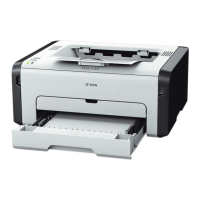





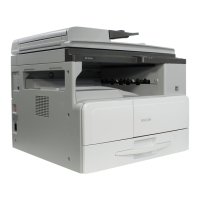
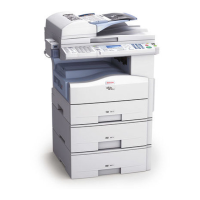
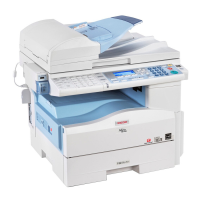
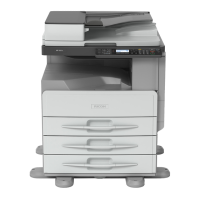
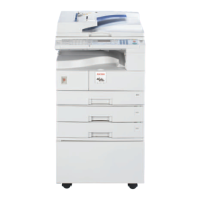

